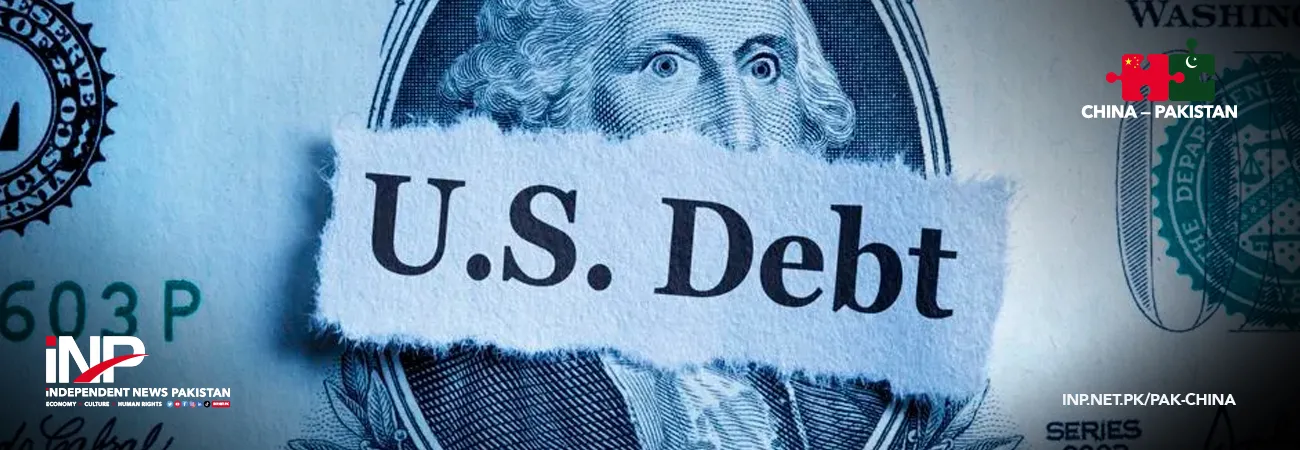i NEWS PAK-CHINA
How the Global economy is paying for the U.S. debt crisis, a detailed review was made in a report published by Gwadar Pro on Friday. Just one day before a potential U.S. government shutdown, U.S. President Joe Biden signed a stopgap funding bill on November 16th to keep the federal government operational. This act essentially means that U.S. policy-makers have once again deferred the fiscal time bomb by a few months. In reality, the U.S. debt issue has become a persistent ailment for both the American government and global investors. As the Federal Reserve enters a cycle of interest rate hikes, U.S. debt has been snowballing and will potentially trigger an avalanche in the international financial system. Just how large has this snowball become? The U.S. federal debt, as reported by the U.S. Treasury Department on October 26th, 2023, has skyrocketed to $33.67 trillion, an increase of $2.27 trillion since the temporary suspension of the $31.4 trillion debt ceiling took effect on June 3rd, 2023, set to expire at the beginning of 2025. The debt is projected to exceed $50 trillion by 2030.
The massive fiscal deficits accumulated over the long term are a significant driver of the ballooning federal debt. During the 2018 financial crisis, the U.S. government implemented two rounds of fiscal stimulus, totalling approximately $1.5 trillion. During the COVID-19 pandemic, six rounds of fiscal stimulus policies were introduced, nearing $5.7 trillion. These policies were financed by issuing bonds on a large scale. From 2007 to 2019, the U.S. government debt increased by about $14 trillion, and in the little over three years since 2020, it has risen by more than $8.2 trillion. According to a report by National Public Radio (NPR), the recent significant rise in federal government spending can be attributed to major factors such as the wars in Afghanistan and Iraq, the increased healthcare costs due to the COVID-19 pandemic and an aging population, as well as a rise in other social service expenditures by the government. The three main budget items—defense, healthcare, and social security—collectively account for as much as 60% of the budget and are considered essential.
Additionally, the long-standing current account deficit has been covered by increasing national debt. In 2022, the U.S. trade deficit in goods and services soared by 12.2% from $845.1 billion in 2021 to $948.1 billion, marking a record high for the third consecutive year. The U.S. has long been in a state of trade deficit, necessitating substantial financing or borrowing to bridge the gap. The U.S. Congress established a maximum debt threshold for the federal government as early as 1917, known as the "debt ceiling" or "national debt limit." From a systemic design perspective, the debt ceiling aligns with the common interests of the United States and all its creditors. It serves as a critical component in maintaining the U.S. government's debt credibility and the hegemony of the dollar, as well as a declaration of creditworthiness to creditors. However, in practice, the U.S. Congress has raised the debt limit over 110 times since 1917, from $11.5 billion in 1917 to $1 trillion in 1982, $10 trillion in 2008, $20 trillion in 2017, and breaking $30 trillion in 2022. The debt ceiling has become a defensive line that greed continuously pushes back.
This supposed limit has been stretched continuously, symbolizing a defense line under siege by insatiable greed. The question arises: where is the ceiling for the debt limit? By the end of the 2022 fiscal year, the size of the U.S. debt ceiling as a percentage of GDP had soared to 125%; the Congressional Budget Office predicts it will reach 185% by 2052. Legally, Congress is granted the regulatory authority to impose limits on the total national debt, but there is a lack of regulation regarding the direction and purpose of bond funds. This has led to a situation where the federal government, to achieve its policy objectives, opts to continuously increase the scale of fiscal expenditures, which are fundamentally unable to cover fiscal outlays, resulting in a fiscal deficit. This phenomenon pressures Congress to submit to reality and repeatedly raise the debt limit, compelling Congress to concede. On November 10th, Moody's announced a downgrade of the U.S. sovereign credit outlook from 'stable' to 'negative,' while affirming its AAA rating. Previously, Fitch and Standard & Poor's had downgraded the U.S. sovereign credit rating from the top-notch 'AAA' to 'AA+.' Now, all three major international rating agencies express significant concerns about the prospects of U.S. sovereign debt.
The loss of confidence worldwide is catastrophic for U.S. Treasuries, a global anchor for asset values. Another factor affecting the confidence of foreign investors is the politicization of sanctions. According to the '2021 Sanctions Review' released by the U.S. Treasury Department, economic and financial sanctions imposed by the U.S. had exploded over the 20 years since 9/11, with designated entities growing from 912 in 2000 to more than 9,400 by the end of the 2021 fiscal year, not to mention the economic sanctions against Russia implemented in 2022. When the U.S. froze Russian-held U.S. Treasury securities, it wasn't just Russia that felt the chill. Data released by the U.S. Treasury Department on July 18th, 2023, shows that at least 19 countries, including China, Japan, the UK, Belgium, and India, sold U.S. Treasuries, reversing the flow of funds invested in U.S. debt, with a net outflow of $167.6 billion. China has been selling U.S. Treasuries in 20 of the past 22 months, and Japan, the largest creditor, cut its holdings by $30.4 billion in May. If an asset loses its fundamental trait of creditworthiness, its only path is depreciation.
In late October, long-term Treasury prices plummeted, and the U.S. bond market bore a bearish semblance: the price of 10-year Treasuries fell 46% compared to its peak in March 2020, a drop nearly mirroring the 49% fall of U.S. stock markets after the dot-com bubble burst in 2000; 30-year Treasuries tumbled 53%, close to the 57% crash of U.S. stocks during the financial crisis. On one hand, demand for U.S. Treasuries skyrockets, and on the other, major investors are offloading them, creating a supply-demand gap that has reached $7 trillion. So, the new question arises: who will purchase the $1.784 trillion of newly issued U.S. Treasuries next year? To attract more retail investors to purchase U.S. Treasuries, raising bond yields is an inevitable choice. As of November 23, the yield on 2-year U.S. Treasuries rose 2.7 basis points to 4.91%, a figure that previously reached a high of 5%. Although U.S. Treasuries are considered “debt” that the U.S. never actually has to repay, the resulting interest is inescapable. Despite U.S. Treasury Secretary Janet Yellen recently rebutting Moody's decision to downgrade the outlook for U.S. sovereign debt, asserting the strength of the U.S. economy and the security and liquidity of the bond market, Yellen also had to acknowledge that if long-term interest rates continue to rise, it will challenge the sustainability of the debt.
In fact, high interest rates have already had a noticeable negative impact on the U.S. fiscal situation. For the fiscal year 2023, the U.S. net interest cost reached $659 billion, with interest expenses rising to 2.5% of GDP. It is projected that by the fiscal year 2033, interest expenses for the U.S. federal government will further increase to 3.7% of GDP. When U.S. fiscal revenue cannot cover the interest payments, the debt snowball will continue to grow. One wonders what Federal Reserve Chairman Jerome Powell's expression might be as Yellen expresses confidence. The climb in U.S. bond yields is not only due to supply and demand but also significantly driven by the Fed's rate hikes. With the Fed's consecutive rate hikes over the past year, the U.S. government's debt interest and costs have risen accordingly. The mounting debt burden, coupled with persistent inflation, may increase the fiscal risks faced by the U.S. government and may also, to some extent, weaken market investors' confidence in the dollar. The Fed has raised interest rates to a range of 5.25%-5.5%, the highest target range since 2001. Economic growth is still slightly below expectations, with GDP at 4.9% for the third quarter of this year.
If interest rates surpass economic growth, the debt becomes a noose around your neck – and that's exactly what's happening in the U.S. today. The bullet fired by the Fed has, after several years, struck the U.S. itself, echoing the words of Stefan Zweig: a price is always exacted for what fate bestows. The U.S. debt ceiling rapidly approaches its deadline, sending shockwaves through global markets as investor panic over a potential U.S. government default intensifies market volatility. If risk aversion in the market reaches its peak, the movement of international capital could heavily impact other countries. For instance, in May 2013, when the Federal Reserve signalled an unexpected reduction in its balance sheet, global financial markets plunged into a 'taper tantrum.' Emerging market countries saw significant currency devaluation in the aftermath, with Pakistan still paying the price today. With the U.S. frequently raising interest rates, the dollar debt service burden on emerging markets and developing countries has surged. Data from the International Monetary Fund (IMF) indicate that over a quarter of emerging economies are facing the dilemma of debt default or plummeting bond prices, with around $237 billion in external debt at risk of default.
Over 60% of low-income countries are grappling with a debt crisis. Once hailed as an African development model, Ghana, following Sri Lanka's footsteps, has announced the suspension of debt payments. Argentina teeters on the brink of bankruptcy, Turkey faces a severe trade deficit, and more than a dozen emerging market countries, including Pakistan, are struggling in a quagmire of debt. As the former French President Charles de Gaulle insightfully remarked over half a century ago regarding dollar hegemony: the United States enjoyed "exorbitant privilege" and "deficit without tears" created by its dollar and used its worthless paper note to plunder the resources and factories of other nations. The U.S. views the global economic market as its financial 'floodgate,' on one hand using the strong financial position of the dollar to offload economic recession risks onto other countries. On the other hand, it introduces domestic subsidy policies to lure businesses into shifting production capacity and increasing investment in the U.S.
This stagflation conundrum has an even more profound impact on emerging markets and developing countries. Under the pressure of inflation and capital outflow in the West, emerging markets are forced to follow suit with interest rate hikes, further exacerbating the debt burden and escalating the risk of a debt crisis. It is reported that middle-income countries have reached the highest level of debt service burden in 30 years. In leveraging its hegemonic position to reap global wealth, the dollar truly embodies the title of 'global currency.' It is this 'arrogant privilege' that allows the U.S. to 'indulge in the extravagance paid for by others.' The haughty words of John Connally, Treasury Secretary during the Nixon administration, 'The dollar is our currency, but it's your problem,' have been continuously validated over the decades.
Credit: Independent News Pakistan (INP) — Pak-China









